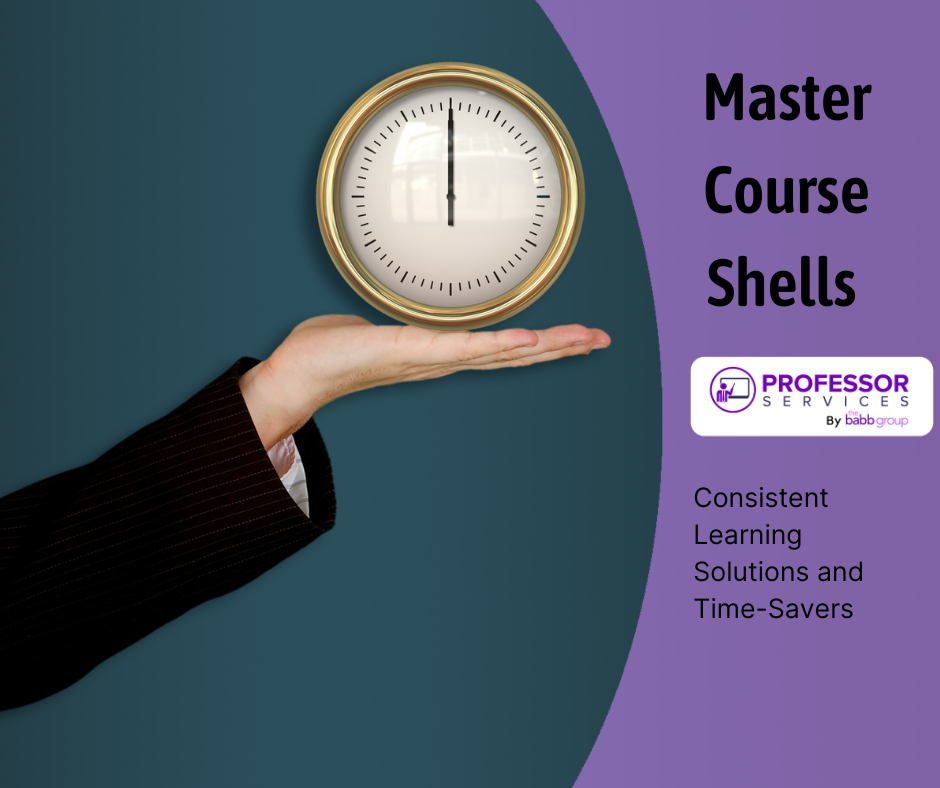As a college professor, you know that developing and delivering online courses can be time-consuming and challenging. However, there is a solution that can help you streamline the process, save time, and improve the quality of your online courses. The solution is to create and use master courses. The Babb Group uses master course shells with its university and institutional partners. As faculty, we know what a time-saver it is when you teach a course again. Here are some practical tips to help you get started.
What are Master Courses?
Master courses, also known as master shells, are pre-designed and fully developed online courses that can be used as the primary content every time the course is taught. Master courses may include content, assignments, assessments, discussions, instructor guides, and other components. By using a master course, you can save time and effort in online course development while ensuring that your courses offer a consistent learning experience for students, meet quality standards, and align with your institution’s goals and objectives.
Benefits of Master Courses for Online Course Development
Consistent Learning Experience
One of the primary benefits of a master course is that no matter who is teaching the course, students will have a consistent learning experience. With a focus on student retention and student success, an institution will receive an immediate payback with less student confusion on where information is placed, an assurance that topics are covered completely, with robust content and engaging activities in a consistent format.
Saves Time and Effort
One of the most significant benefits of using master courses is that it saves time and effort in online course development. With a pre-designed and fully developed master course, you don’t have to start from scratch whenever you create a new course. You can reuse course components, such as assignments, quizzes, and discussions, and focus on customizing the course to meet the needs of your students and the learning outcomes. Depending on the LMS, you can copy an entire master course into a specific shell or multiple sections. This saves time from creating a new course in the LMS every semester.
Ensures Consistency and Quality
Using a master course ensures that the quality of the course content is consistent across multiple offerings of the same course. While students will have unique learning experiences and relationships with various instructors, the core assignments and rubrics remain the same. This consistency in quality can lead to better student learning outcomes and satisfaction when different professors teach the same course.
Need experienced instructional designers who know your LMS to collaborate with your team?
Flexibility in Course Design
A master shell does not mean the course is locked down. Depending on the institution, professors have varied degrees of flexibility within the course. Instructors can easily modify and customize the course content to fit the needs of their specific class or group of students. This allows instructors to incorporate their own experience and knowledge to create a unique and tailored learning experience for their students. Announcements, lectures, videos, weekly introductions, and discussions are often areas where instructors can share their experiences and customize the course.
How to Create a Master Course
To create a master course, follow these simple steps:
- Identify the course that you want to create a master course for.
- Determine the course learning objectives.
- Develop assessments and assignments.
- Gather all necessary content, such as lectures, videos, texts, and other resources.
- Consult your institution for guidelines in setting up the classroom in the LMS.
- Create a master course template in the LMS.
- Upload the course content to the master course template.
- Save the master course for future use.
- Copy as needed.
Make adjustments, corrections, and improvements after every semester.
Creating and using master courses can save time and effort in course development while maintaining course quality and consistency. By following the simple steps outlined above, instructors can easily create and reuse master courses for multiple offerings of the same course. This leads to a better student learning experience and a more efficient teaching experience for instructors.
Angela
Latest posts by Angela (see all)
- The Art of Connection: Networking and Professionalism in Academia - July 25, 2024
- Got the Teaching Job? Now, You Need To Attend the Faculty Training - July 1, 2024
- Higher Education Trends: Insights from Our COO, Sheila Fry - June 20, 2024
